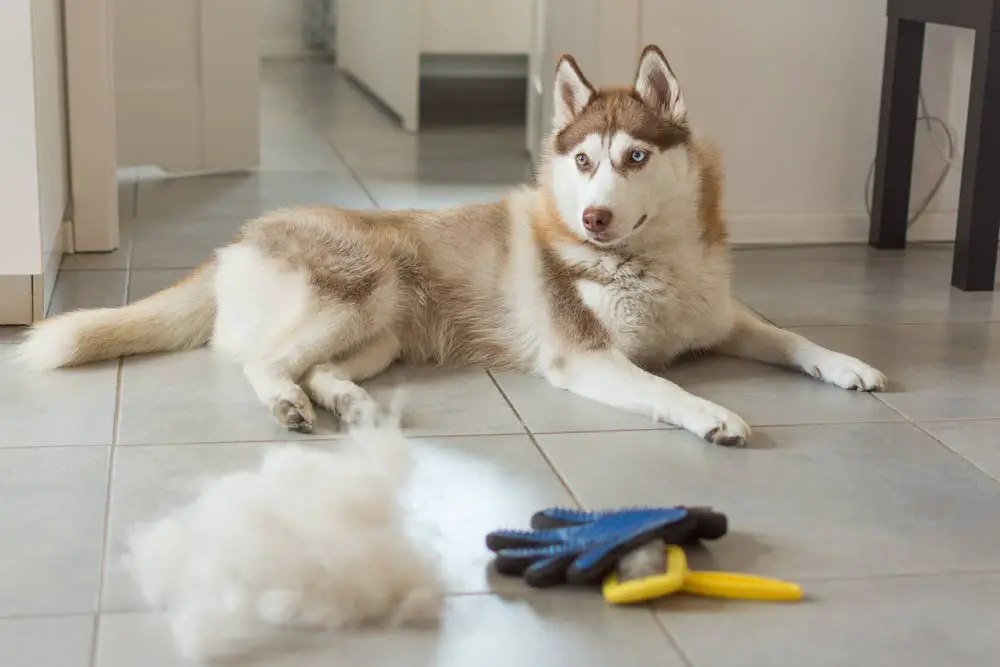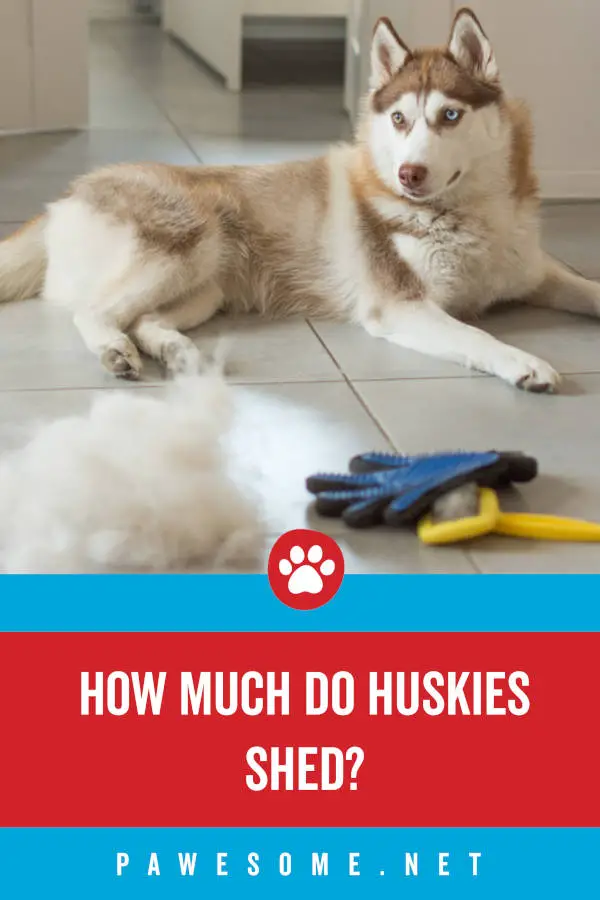
Huskies are sled dogs popularly used in the polar regions for, well, pulling sleds and heavy loads. However, they can also be seen outside of this habitat and make for great pets even in the city and in warmer places than the poles.
In fact, retired adventure trekking huskies often find homes in cities as pets. The Siberian Husky and Labrador Husky are two popular husky breeds that are registered with various kennel clubs.
Do Huskies Shed?
The short answer to this question is yes. Huskies shed a lot. In fact, first-time husky owners can find themselves to be surprised at how much a husky sheds.
Most other breeds of dogs shed throughout the year, but huskies typically shed seasonally. However, the amount of hair that is shed can add up to a lot throughout the year.
The seasonal shedding of hair is for them to regulate their body temperature based on weather. This is a routine thing and should not alarm you. This is known as ‘blowing’ of the undercoat.
What Does ‘Blowing’ Mean?
The blowing of the undercoat is a phase that occurs during season change. The blowing phase can last between 3-5 weeks when the husky sheds. The husky’s body is making changes to acclimatize to the new season.
Huskies have two layers of coats and the undercoat sheds twice or thrice a year, depending on the season. The undercoat will come out in clumps during this blowing phase and can make the husky’s coat look patchy. But this is completely normal.
During this period, the husky will lose hair that almost adds up to the entire surface area of its body. This helps them stay cool when the weather becomes warmer. Remember, huskies prefer to be in cool weather so the heat can be quite bothersome for them.
With the onset of winter, they will start growing their undercoat back. In some cases, a husky may even shed their summer coat during the fall season so the winter undercoat can grow back in time for the season.
What Does the Husky Double Coat Do?
To make this simpler, think of it this way—huskies have coats for two seasons, one for heavy winters and the other for light summers. This is an ingenious way for the sled dogs to be comfortable during both seasons.
The undercoat is thick during the winters, keeping the husky insulated and warm. This is why you will see a husky sit in the snow without as much as flinching a muscle. They also have a top layer of longer hair that repels water and keeps them dry.
While this double coat is ideal for the winters and the snow, it becomes too thick for dealing with the summers. If a husky is not able to shed the undercoat for the summer, it will remain uncomfortable and can even fall sick.
With the change in the season, therefore, huskies ‘blow’ the extra coat. The husky will still have a double coat, but the undercoat is not as thick as the winter coat. While huskies may shed twice or thrice a year, the spring ‘blowing’ is the maximum.
You may have noticed that a husky has two colors on its coat, a darker grey or brown and white. The white coat is the dense undercoat, while the darker fur makes up the longer topcoat. The outer coat is slightly oily so it can repel water and rain.
Related: Why are Huskies so Vocal?
Is Husky Hair Hypoallergenic?
Since huskies do not shed throughout the year and only during the blowing period, people often assume that they are not hypoallergenic. While they shed the most during the blowing period, it is not as if they do not shed at all during the rest of the year.
Besides, the fur they lose during the blowing period is a lot and adds up to the amount of hair a dog of a different breed may shed through the year. Therefore, the shedding may still trigger allergies.
Besides, the dander or tiny flecks of skin they shed can also cause allergies as these are often microscopic particles that can irritate the sinus or trigger other allergies. So if you are allergic to dog hair or other pet dander, you will not be immune to huskies.
How Can You Manage the Hair Shedding?
The hair shedding during the blowing phase can be quite challenging to manage. To say a husky sheds a lot of hair during this phase would be a gross understatement. You can build a whole other dog with the amount of hair a husky might shed during this period!
Moreover, this happens from the first year of a husky’s life, right up to the end. If a husky stops blowing their undercoat, that is when you should worry and consult a vet. If their hair is coming off in clumps during spring, consider things to be on track!
However, this does not mean your home has to be covered in the hair during this period. There are steps you can take to manage the shedding and ensure your furniture is not covered in your dog’s hair.
Brushing
It is important to brush your husky’s hair daily. If you have a pup and notice that they have begun to shed, you should incorporate brushing into their daily routine. Husky puppies are born with a softer coat. The double coat comes in at 6-12 weeks. This is when you need to start brushing them.
You should designate a single spot in your home for brushing so the fur does not shed everywhere. By brushing regularly, you can prevent clumps from forming and can remove hair more routinely than have it all shed on your sofa at once.
Regular brushing prevents the matting of hair and keeps its hide clean and smooth. Start young and make it a practice your husky enjoys as well so you do not need to fight your pet every time you need to brush your hair.
Think of owning a pet as having a child. You would have to brush your child’s hair, wouldn’t you? Dogs are the same except they cannot do certain things for themselves even when they grow older.
Using the Right Tools
It is apparent by now that husky hide is not the same as any other dog’s. These are dogs that are programmed to withstand extremely cold and extreme weather. The coat is protection for all dogs, but this is especially true for huskies. Their coats are crucial to their survival.
Therefore, the right tools must be used when you are managing their coat. A regular dog brush will not cut it because they are generally designed for dogs with lighter sheds. Using this brush on a husky will clog the brush up within two strokes.
It might be better to first use a brush with large gaps between the teeth. This brush is shaped somewhat like a rake and it is good to collect hair without getting stuck in the dense fur. It is also easier to clean a rake-like brush.
Once the first brush is going through the fur without getting stuck, you can switch to a finer brush for all the hair that the larger brush could not collect.
Vacuuming
Finally, it is of the utmost importance to invest in a good vacuum cleaner. Merely sweeping up the hair will not be of much use once the blowing season begins properly. You need a powerful vacuum cleaner to remove the hair from upholstery, carpets, clothes, etc.
Just as you will need to incorporate brushing your husky into your daily routine, you will also need to vacuum daily or at least thrice a week.
Should You Shave Your Husky?
Absolutely not! The only time it is okay to shave a husky is if it needs to go into surgery. Not only will shaving your husky make them look strange and disturbing (the body of a husky is not as large as the hair makes it seem), the hair is also important for temperature control.
No matter how hot it is, the husky’s body will figure out how to regulate temperature with the help of the double coat. Do not intervene in this natural process, you could expose your dog to a variety of health risks and infections.
For any other dog, it may be okay to shave their hair off. But this is never advisable for a husky so refrain from doing this, no matter how well meaning your intentions are. If these warnings are not convincing enough, simply look up images for a shaved husky and you will immediately rethink your plans!
Conclusion
In conclusion, yes, huskies shed—they shed a lot! If you are looking for a pet that does not require too much maintenance, you should perhaps not even consider a husky, especially if you live in a warmer climate.
A husky will blow its undercoat twice or thrice a year, where you will notice clumps of hair falling off. If you brush your husky’s coat every day, the blowing phase can be managed better, but it will still be a lot of hair—this cannot be prevented.

